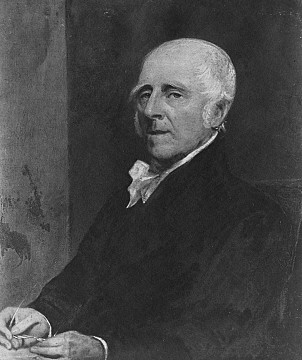Col. John Stevens (1749-1838)
III, Inventor & Engineer, of "Castle Point" Hoboken, New Jersey
He was born in New York City, the only son of the Vice-President of the New Jersey Provincial Council and the brother-in-law of Chancellor Robert R. Livingston. He graduated from King's College (Columbia University) in 1768 and was admitted to the Bar of New York City in 1771. In 1776, he was appointed a Captain in Washington's army. During the war, he was promoted to Colonel and served as Treasurer of New Jersey from 1776 to 1779. In the early 1780s, he purchased the land that now comprises the City of Hoboken after it was confiscated from William Bayard. On his new estate, Stevens built Castle Point, where the Stevens Institute of Technology now stands.
He was a member of the American Philosophical Society and the inventor who is credited with helping to introduce the U.S. patent system in 1790. In 1806, he built the Phoenix that three years later became the first screw-driven steamship to successfully navigate the open ocean. In 1811, another of his boats, Juliana, became the first steam-powered ferry in the U.S., operating between Hoboken and New York City. The first railroad charter in the U.S. was given to Stevens and his partners in 1815 for the New Jersey Railroad which essentially gave them a monopoly on railroads in the state of New Jersey. In 1825, he both designed and built a steam locomotive which operated on a circle of track at Castle Point.
In 1782, he married Rachel, daughter of Colonel John Cox, owner of the Batsto Ironworks. They were the parents of thirteen children, eleven of whom (listed) survived infancy. The Stevens' children were first cousins of the Livingstons of Clermont. Their eldest son, John Cox Stevens, lived at Annandale (also known as Blithewood) and was the first Commodore of the New York Yacht Club. Their youngest son, Edwin Augustus Stevens, inherited Castle Point and founded the Stevens Institute of Technology.
He was a member of the American Philosophical Society and the inventor who is credited with helping to introduce the U.S. patent system in 1790. In 1806, he built the Phoenix that three years later became the first screw-driven steamship to successfully navigate the open ocean. In 1811, another of his boats, Juliana, became the first steam-powered ferry in the U.S., operating between Hoboken and New York City. The first railroad charter in the U.S. was given to Stevens and his partners in 1815 for the New Jersey Railroad which essentially gave them a monopoly on railroads in the state of New Jersey. In 1825, he both designed and built a steam locomotive which operated on a circle of track at Castle Point.
In 1782, he married Rachel, daughter of Colonel John Cox, owner of the Batsto Ironworks. They were the parents of thirteen children, eleven of whom (listed) survived infancy. The Stevens' children were first cousins of the Livingstons of Clermont. Their eldest son, John Cox Stevens, lived at Annandale (also known as Blithewood) and was the first Commodore of the New York Yacht Club. Their youngest son, Edwin Augustus Stevens, inherited Castle Point and founded the Stevens Institute of Technology.







